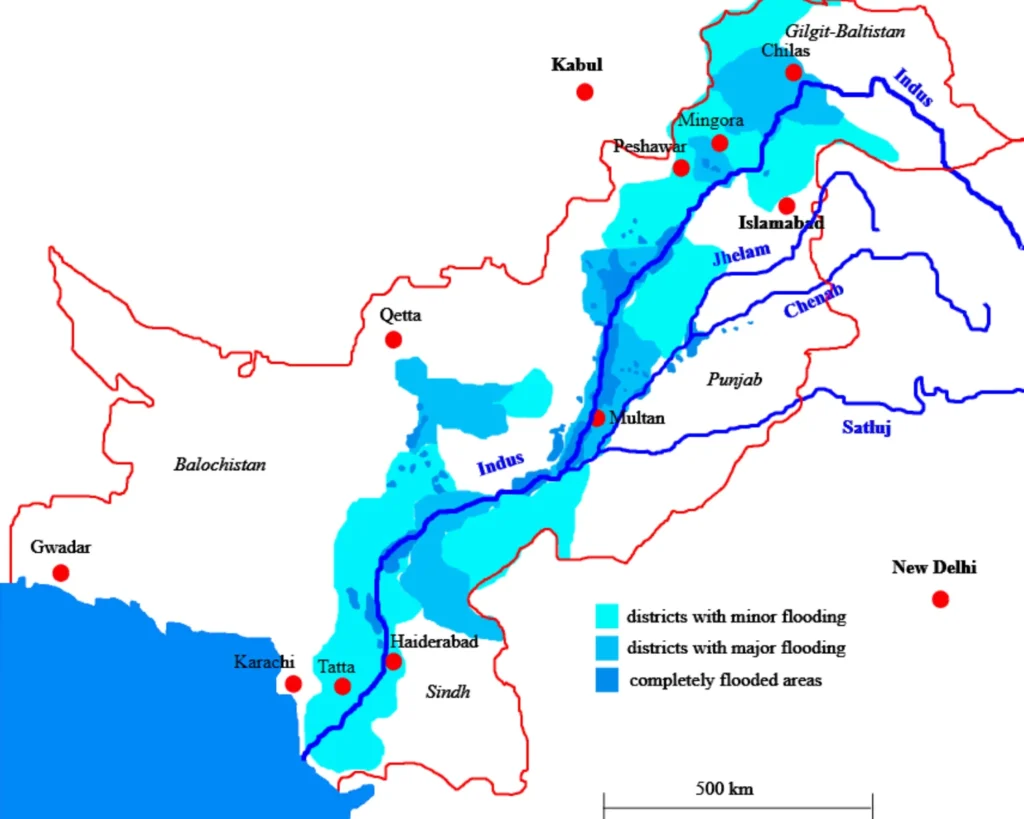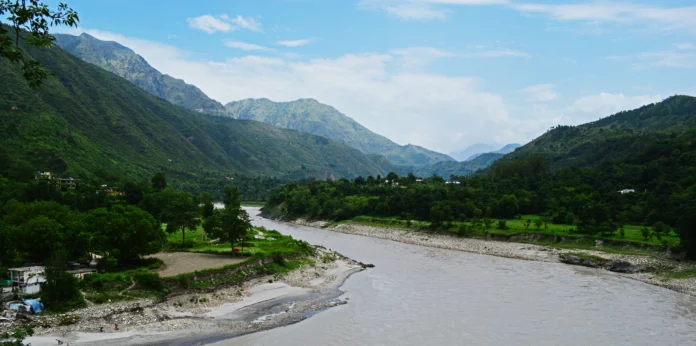Introduction: A River in Crisis
Saving the Lower Sutlej River Basin is not just an environmental necessity—it is a fight for the survival of Punjab’s people, agriculture, and ecosystems. The Sutlej River is more than a body of water; it is the lifeline of the region, sustaining millions. However, industrial pollution, mismanagement, and climate change are pushing this once-thriving river toward an unprecedented crisis. Toxic waters, disappearing glaciers, and misallocated resources are accelerating its decline. This guide delves into the challenges, research insights, and urgent solutions needed to revive the Lower Sutlej River Basin before it’s too late.
Understanding the Lower Sutlej’s Environmental Decline
1. Pollution and Industrial Waste
The lower Sutlej and its tributaries, the Kali Bein and Chitti Bein, are choking on industrial discharge and untreated sewage. Once vibrant aquatic ecosystems are now toxic wastelands, where oxygen levels are too low to support life. Fish populations have plummeted, and bird species that depended on the river are dwindling. Without strict regulations on industrial effluents, the river’s decline will only accelerate.
The Role of Agriculture in Water Contamination
Agricultural runoff is another major contributor to the Sutlej’s pollution crisis. Excessive pesticide and fertilizer use leads to chemical leaching into the river, poisoning aquatic life and reducing water quality for human consumption. Organic farming initiatives and better water treatment facilities are urgently needed to mitigate this threat.
The Rise of Plastic and Urban Waste
Increasing urbanization along the Sutlej has exacerbated its pollution crisis. Plastic waste, untreated sewage, and industrial chemicals flow freely into its waters. Cities like Ludhiana and Jalandhar generate enormous waste, much of which ends up in the river due to inadequate waste management infrastructure. Strengthening municipal waste treatment facilities is crucial to reducing this burden.
2. Vanishing Glaciers and Water Scarcity
The Sutlej’s flow is largely dictated by Himalayan glaciers, which are disappearing at alarming rates. Between 1984 and 2013, glacier volume feeding the Sutlej decreased by 21%. By 2050, glacial water flow is expected to drop by 50%, and by 2090, only 3% of these ice reserves will remain. This will drastically reduce the river’s water supply, exacerbating shortages in Punjab and beyond.
How Climate Change Exacerbates the Crisis
Rising global temperatures not only accelerate glacial retreat but also alter precipitation patterns. Monsoon seasons are becoming more erratic, with either prolonged droughts or devastating floods. This unpredictability makes water resource management even more challenging.
3. Unpredictable Flooding and Erosion
The Sutlej is no longer a steady provider of life—it alternates between destructive floods and prolonged droughts. Poor watershed management leads to excessive runoff, soil erosion, and water misallocation. This was evident in July 2023 when Lohian Khas, Jalandhar, experienced severe flooding, devastating homes and farmland. If unchecked, this pattern will continue, leaving Punjab’s districts vulnerable to recurring disasters.
The Impact on Agriculture and Rural Communities
Flooding doesn’t just damage infrastructure; it wipes out entire harvests, plunging farming communities into economic despair. Crop losses translate into food shortages, rising prices, and long-term instability for Punjab’s agrarian economy. Conversely, prolonged dry spells driven by climate change result in failing crops, forcing farmers to rely on groundwater, which is depleting at an unsustainable rate.
Ranking the Most At-Risk Watersheds
A recent morphometric and Principal Component Analysis (PCA) study ranked 14 watersheds in the lower Sutlej basin based on their vulnerability. The results revealed that WS7 (Lower Shivaliks) is the most at risk due to its steep slopes and high agricultural land use (67.56%). This makes the area highly susceptible to erosion and soil degradation, threatening both farming and groundwater recharge.
Ranking of the Most Vulnerable Watersheds
Watersheds play a crucial role in maintaining ecological balance, regulating water flow, and supporting biodiversity. However, various environmental and anthropogenic factors contribute to their degradation, leading to severe consequences such as soil erosion, reduced water quality, and habitat loss. Based on a comprehensive assessment, the following watersheds have been ranked in order of vulnerability, highlighting key concerns and necessary interventions.
1. WS7 (Lower Shivaliks) – Highest Degradation Risk
WS7, located in the Lower Shivaliks, is identified as the most vulnerable watershed due to its extreme susceptibility to erosion, deforestation, and land degradation. The steep slopes, fragile soil composition, and increasing human activities, including unsustainable agriculture and infrastructure development, have exacerbated its deterioration. Urgent intervention, including afforestation programs, soil conservation measures, and controlled land use, is critical to mitigating further damage.
2. WS9 – Severe Erosion Concerns
WS9 faces significant soil erosion and sedimentation issues, threatening water retention capacity and downstream water quality. The loss of topsoil not only reduces agricultural productivity but also increases the risk of landslides. Implementing erosion control techniques such as terracing, vegetative barriers, and sustainable land management practices is essential for its rehabilitation.
3. WS3 & WS4 – High Susceptibility to Soil Loss
Both WS3 and WS4 exhibit high rates of soil loss due to deforestation, overgrazing, and erratic rainfall patterns. These watersheds require immediate attention through reforestation efforts, soil conservation strategies, and the promotion of sustainable farming techniques to prevent further degradation.
4. WS11 & WS10 – Moderate Risk with Worsening Conditions
Although WS11 and WS10 are categorized as having a moderate risk, recent environmental trends indicate deteriorating conditions, with increased deforestation and unregulated land use accelerating soil erosion. Proactive land and water management strategies, such as agroforestry, contour plowing, and watershed restoration programs, can help stabilize these regions.
5. WS1, WS14, WS5, WS6 – At Risk, but Manageable with Intervention
WS1, WS14, WS5, and WS6 face notable but manageable degradation risks. If conservation efforts, such as controlled grazing, watershed-friendly agricultural practices, and community-based environmental stewardship, are implemented in a timely manner, these areas can recover without experiencing severe long-term damage.
6. WS8, WS2, WS12, WS13 – Lower Priority but Still Requiring Attention
While WS8, WS2, WS12, and WS13 currently exhibit lower levels of degradation, they remain susceptible to environmental threats such as seasonal droughts, encroachment, and deforestation. Continuous monitoring, preventive measures, and sustainable land-use planning are necessary to ensure these watersheds remain resilient against future challenges to the environment.
Addressing watershed vulnerability requires a scientific, data-driven approach, incorporating sustainable land management, community involvement, and policy-driven conservation efforts. Prioritizing at-risk watersheds and implementing tailored interventions can help preserve these critical ecosystems, ensuring long-term environmental and socio-economic stability.
Key Geographic and Climatic Insights
- Punjab’s climate is marked by scorching summers, chilly winters, and erratic monsoons, with 75% of its rainfall occurring between July and September.
- The Shivalik foothills, characterized by slopes up to 40%, intensify runoff, stripping away nutrient-rich soil and reducing natural water absorption.
The Political Battle Over the Sutlej

The Sutlej isn’t just an environmental issue—it’s a political one. Governed by the Indus Water Treaty (1960), the river’s waters are allocated between India and Pakistan. However, within India, disputes between Punjab, Haryana, and Rajasthan over water rights are escalating. Punjab, already suffering from groundwater depletion, is forced to divert water beyond its basin, undermining the sustainability of local agriculture.
How Water Mismanagement Deepens the Crisis
Unregulated groundwater extraction has further exacerbated water shortages. Farmers, desperate for irrigation, dig deeper wells, depleting underground reserves that took centuries to accumulate. Without a comprehensive water-sharing agreement, conflicts will only worsen.
A Sustainable Path Forward
1. Strengthening Water Governance
- Establish a Punjab Water Management Board with real regulatory power.
- Expand the role of the Punjab Water Resources Regulatory Authority (2020) to enforce stricter water conservation policies.
- Recognize the interconnectedness of the Sutlej, Beas, and Ravi as a single hydrological system.
2. Reviving the Sutlej’s Biodiversity
- Implement stricter regulations on industrial pollution with regular water quality monitoring.
- Restore aquatic ecosystems by reintroducing native fish species and preserving wetlands.
- Strengthen afforestation efforts in key watershed areas to stabilize soil and improve water retention.
3. Climate Adaptation Strategies
- Promote sustainable irrigation by shifting from flood irrigation to micro-irrigation techniques (e.g., drip and sprinkler systems).
- Invest in climate-resilient farming practices, such as crop diversification and rainwater harvesting.
- Develop flood-resistant infrastructure, including bioengineering solutions to prevent embankment breaches.
4. Community Involvement and Awareness
- Launch public education campaigns about water conservation and sustainable farming.
- Encourage community-led river clean-up efforts to reduce plastic waste and pollutants.
- Provide incentives for farmers adopting eco-friendly agricultural practices.
Conclusion: The Time to Act Is Now
The Sutlej River’s decline is not just an environmental crisis—it is an existential threat to Punjab’s future. Without immediate intervention, the state faces escalating water shortages, ecological collapse, and economic devastation. The solution lies in a multi-pronged approach, combining policy reform, scientific innovation, and community-driven conservation efforts.
The river has given life to Punjab for centuries. It is time for Punjab to give back—to restore, to protect, and to ensure that the Sutlej continues to flow for generations to come.


